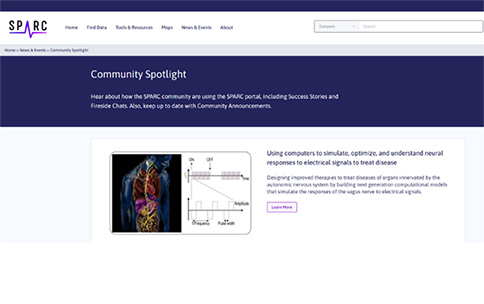
Peripheral nerves are spread throughout the body, sending signals from our limbs and organs back to the brain and spinal cord allowing us to feel stimuli, such as the warmth from the sun, and to move our limbs to accomplish our daily activities. Bioelectronic medicine sends similar electrical signals to nerves in our body to treat a wide variety of diseases, such as epilepsy, heart failure, rheumatoid arthritis, and obesity. However, more research is needed to discover how much electrical stimulation is needed, where to apply it, and how to best use this technology for each individual patient and condition. Researchers from the NIH Common Fund’s Stimulating Peripheral Activity to Relieve Conditions (SPARC) program have created new digital technology to better understand the effects of nerve stimulation, as well as to aid in designing, building, and running next generation computational models to advance the field of bioelectronic medicine.
This research team at Duke University, led by Dr. Nicole A. Pelot, has developed the Automated Simulations to Characterize Electrical Nerve Thresholds (ASCENT) pipeline, which builds 3D models of nerves using cuff electrodes to simulate individual neuron responses to electrical signals. This technology has been used to compare existing models of individual neurons, as well as new models of neurons in peripheral tissues of the body, that reproduce previously published laboratory experimental results using computational methods. The team at Duke University has used ASCENT technology in collaboration with researchers at the University of Wisconsin-Madison to reveal key pathways for side effects of vagus nerve stimulation, a bioelectronic medicine treatment used to treat epilepsy. These results can serve as a guide to avoid side effects of epilepsy treatment and increase the therapeutic effects of bioelectronic medicine in the treatment of this disease. The ASCENT pipeline has the potential to advance the field of bioelectronic medicine by streamlining the creation of new reproducible computational models of nerve stimulations that can be used to treat a variety of conditions, while factoring in the individuality of specific individuals and details of their unique nervous system makeup.
Learn more about this work on the SPARC Portal Community Spotlight page.
Reference
- ASCENT (Automated Simulations to Characterize Electrical Nerve Thresholds): A pipeline for sample-specific computational modeling of electrical stimulation of peripheral nerves. Musselman E, Cariello J, Grill W, Pelot N. PLOS Computational Biology. 2021 August 26. DOI: 10.1371/journal.pcbi.1009285


